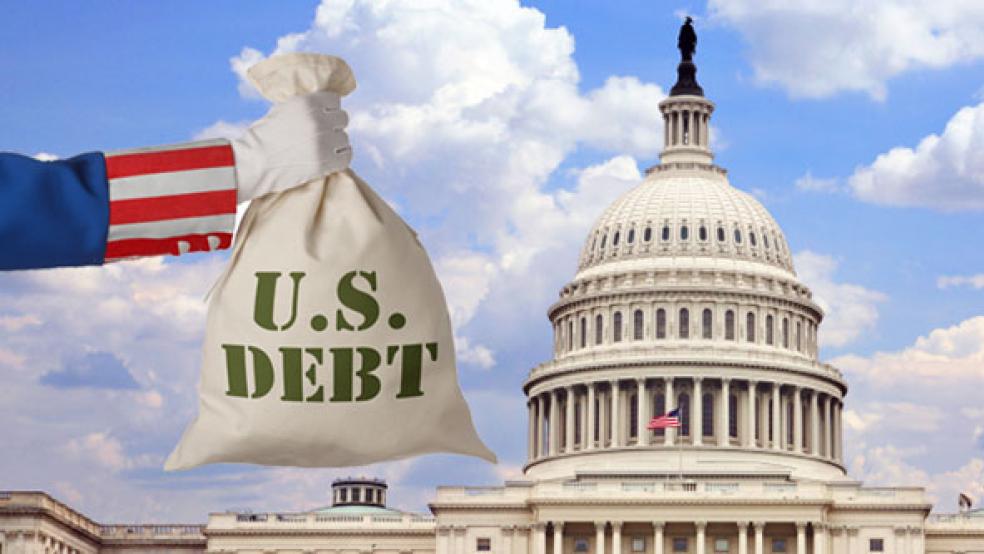When President Obama delivers his State of the Union address Tuesday evening, here’s one thing you won’t hear: an ambitious new plan to rein in the national debt.

In recent weeks, the White House has pressed the message that, if policymakers can agree on a strategy for replacing across-the-board spending cuts set to hit next month, Obama will pretty much have achieved what he has called “our ultimate goal” of halting the rapid rise in government borrowing.
“Over the last few years, Democrats and Republicans have come together and cut our deficit [over the next decade] by more than $2.5 trillion through a balanced mix of spending cuts and higher tax rates for the wealthiest Americans,” Obama said during his weekend radio address. “That’s more than halfway towards the $4 trillion in deficit reduction that economists and elected officials from both parties say we need to stabilize our debt.”
By the administration’s math, Washington needs to enact only another $1.5 trillion in 10-year savings to hit the $4 trillion target, White House economic adviser Jason Furman told reporters last week. At $1.2 trillion, the automatic cuts, known as the sequester, quite nearly fit the bill.
Deficit hawks have reacted with alarm to the administration’s position. Since a calamitous recession hit in December 2007, the amount the government owes outside investors has more than doubled, soaring from about $5 trillion to more than $11.6 trillion. By the end of this year, the debt will top $12 trillion, according to new projections from the nonpartisan Congressional Budget Office — about 76 percent of the nation’s economy.
Cutting an additional $1.5 trillion would indeed stabilize the debt, leaving it growing at about the same rate as the broader economy for the rest of the decade, the CBO said. However, the debt would remain above 73 percent of gross domestic product — the highest level in U.S. history except for the period after World War II.
That’s much higher than the 62 percent target policymakers set three years ago when Obama appointed the Bowles-Simpson fiscal commission. And because policymakers have avoided changes to the big federal health and retirement programs, the debt would start rising again after 2023 as the bulk of the baby-boom generation retires.
“You don’t do half the job and say you’re done,” said Maya MacGuineas, president of the bipartisan Committee for a Responsible Federal Budget. “And stabilizing the debt is just half the job.” As MacGuineas spoke, her organization released an updated analysis of the issue titled “Our Debt Problems are Far From Solved.”
“While the deficit reduction enacted to date represents notable progress, lawmakers have achieved only slightly more than half of the minimum necessary deficit reduction to achieve sustainability over the next decade by our estimates,” the report says. “. . . [T]he debt-to-GDP ratio is on a path to reach about 79 percent by 2023 under our current policy projections, rather than 91 percent of GDP absent this deficit reduction. Though this represents a notable improvement, it still leaves debt on an upward path — rising from 73 percent of GDP today to nearly 130 percent by 2040.”
The report concludes that policymakers need to find an additional $2.4 trillion in savings to put the debt on “a clear downward path.” A similar report released Monday by the Democratic group Third Way calls for additional savings of roughly $2 trillion.
A third report, by the left-leaning Center on Budget and Policy Priorities, on Monday backed the White House target of $1.5 trillion as “the minimum appropriate budget policy.” Though it would not “permanently solve our fiscal problems, it would still represent an important accomplishment,” the report says.
However, the center’s analysts concluded that “a somewhat larger amount of deficit reduction would be desirable, if it can be secured through sound, balanced policies that don’t impede the economic recovery . . . don’t increase poverty and inequality (which are already larger in the United States than in most of the Western world), and don’t sacrifice health care quality or access or raise overall U.S. health care costs.”
That is a direct shot at House Republicans, who have set their sites on finding roughly $4 trillion in savings on top of the sequester, which is what the CBO says is needed to wipe out deficits entirely by 2023.
That is a whopping figure, and House Republicans have pledged to do it without raising taxes, cutting military spending or reducing current benefits for the elderly. That does not leave them much to cut. But if they can do it, it would bring the debt ratio down dramatically by 2023, to less than 60 percent of GDP, according to CBO estimates.
Administration officials say that the president is willing to consider more than $1.5 trillion in additional savings and that his most recent offer to House leaders, worth around $1.8 trillion, remains on the table. That proposal includes changes to Social Security and federal health programs that would produce even bigger savings after 2023.
However, Obama is insisting that any new package include new revenue. It does not have to be 50/50, Furman told reporters; he suggested a ratio of $900 billion in spending cuts to $600 billion in tax hikes. But with Republicans opposed to more tax increases, the parties are facing the same old stalemate for the third year in a row.




